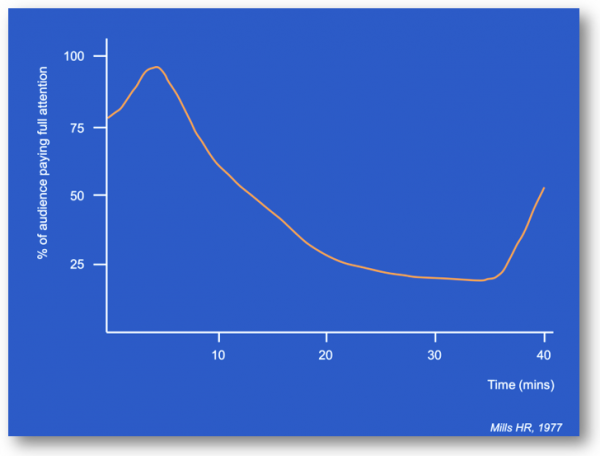Imagine attending a dinner party that begins with scrumptious hors d’oeuvres and drinks, proceeds to a delicious meal with lively conversation, concludes with a decadent, mouth-watering dessert, and then the host suddenly exclaims, “Sorry, we’ve run out of time!” and hustles everyone out the door in thirty seconds. A perfect evening has just been ruined by an abrupt ending, and as you hastily depart, you’re probably thinking, “We’re never going there again.”
This unspeakably rude scenario has an all-too-common analog in the public interest sector. More often than I can count, I have attended presentations and webinars which got off to a promising start, delivered solid content, but dropped the closing curtain with the speed (and equally disconnecting effect) of a guillotine blade. Now, I don’t wish to imply that a mangled ending automatically invalidates everything that came before, but your closing is a critically important part of the entire experience.
In short: endings matter, especially when your objective is to inform, educate, or motivate. So, as we head into December and bring another year to a close, what better time than now to focus on the best ways to end a presentation, webinar or just about any gathering of humans be it face-to-face or screen-to-screen.
 In his book, Teaching & Training: A Handbook for Instructors (Macmillan, 1977), H.R. Mills presents a graphic rendering of students’ attention spans in the classroom (see illustration). “Interest starts off high,” Mills writes, “though no matter how good an instructor may be, he will rarely have the full attention of all the class. Interest drops. Fatigue and boredom set in and persist until banished by the pleasant anticipation of the end of the period” (italics mine.)
In his book, Teaching & Training: A Handbook for Instructors (Macmillan, 1977), H.R. Mills presents a graphic rendering of students’ attention spans in the classroom (see illustration). “Interest starts off high,” Mills writes, “though no matter how good an instructor may be, he will rarely have the full attention of all the class. Interest drops. Fatigue and boredom set in and persist until banished by the pleasant anticipation of the end of the period” (italics mine.)
Based on my 20+ years of experience giving presentations, leading webinars and also being an audience member, I’m convinced the same pattern exists among our colleagues in the public interest sector. It’s just human nature. When a session begins, we are curious about the speaker(s) and the subject and usually hopeful that the hour (or more) will be time well spent. And when we hear the words, “In conclusion…” even those among us in the deepest reaches of REM sleep will arouse and listen more closely for those words of wisdom that make it all worthwhile.
Most presenters and webinar leaders recognize the importance of a strong opening, but it’s still surprising how many pay scant attention to the ending. “Well, I see we’ve run out of time,” they’ll say before issuing a few perfunctory thank-yous and abruptly ending the session. Given the spike in attention that’s just been handed to them, this is a wasted opportunity. Consequently, I always recommend leaving enough time for a three-step closing:
Step 1: Summarize
There’s a maxim in public speaking that goes so far back I cannot find agreement on the original source: “Tell ‘em what you’re going to tell ‘em; tell ‘em; tell ‘em what you told ‘em.” Step 1 of a good closing is that last piece — simply spending a few minutes recapping the major points that were made during the presentation or webinar.
Step 2: Take Questions
Even if you’ve taken questions earlier in the session, it’s always advisable to have one final Q&A segment to address any lingering concerns. But above all, do not end your presentation with Q&A. Questions may stray from your topic, be relevant for the questioner but not the larger audience, or may not be questions at all – just an opportunity for someone to hold forth and hijack your session. Even if all the questions are on point (which I wouldn’t put money on), letting someone else have the last word is a risky proposition, especially when the audience is paying attention again. Which bring us to the third and most important step in your closing…
Step 3: Stick the Landing
The final minute or two is your opportunity to tell one more story, restate your message as concisely and eloquently as possible, or provide an inspiring vision. Above all, this is your moment to express in no uncertain terms what you hope the audience will do with the information they have just received or the skills just acquired. (If you are moderating a panel discussion, you can give each panelist a prescribed amount of time for a closing statement along these lines.) When you Stick the Landing, you make sure that the last thing ringing in the audience’s ears is the one thing you want them to remember.
Gosh, looks like we’ve run out of space. See you next month! (JK)
